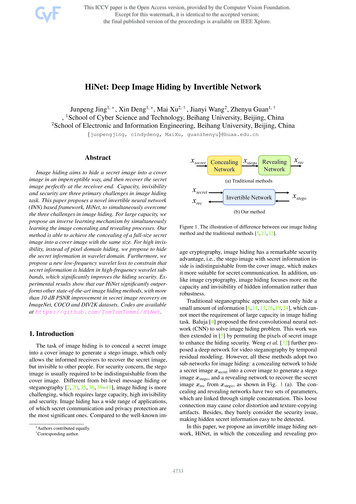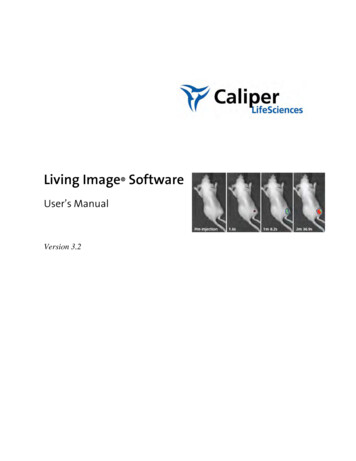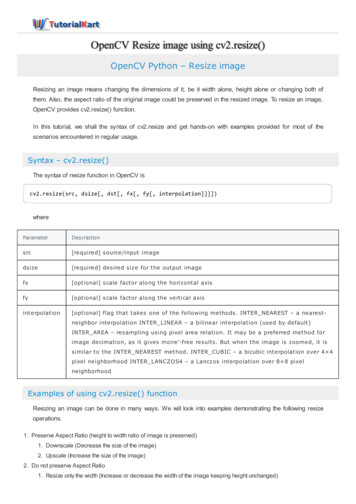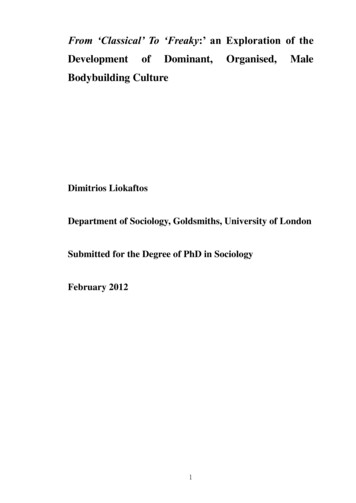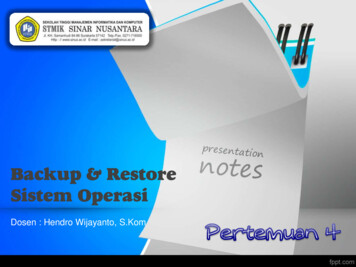
Transcription
ImageImageImageImageImageUNIVERSITY OF CALIFORNIA, LOS ANGELES2009-19 CAPITAL FINANCIAL PLANJuly 2009
Table of ContentsOVERVIEW01CAPITAL PLANNING CONTEXTLong-Range Development Plan (LRDP)Physical Design FrameworkAcademic Planning04III.THE UCLA COMMUNITYAcademic ProgramCampus LifeAdministrative UnitsMedical Enterprise08IV.CAPITAL STRATEGIC INITIATIVESComplete the Seismic Correction ProgramTransform UCLA to a Residential Academic CommunityBuild a Sustainable Campus21CAPITAL PLANNING PROCESS26CAPITAL RESOURCES272009-19 CAPITAL IMPROVEMENT PROGRAMTable 1: Capital Improvement ProgramTable 2: Capital Improvement Program by Fund SourceTable 3: External Financing by ProgramTable 4: Capital Improvement by FunctionTable 5: Capital Improvement by Improvement CategoryTable 6: Capital Improvement by New and Renovated ASF28PROJECT DESCRIPTION TEMPLATES37I.II.V.VI.VII.VIII.IX.APPENDICESA. Draft Academic PlanB. Seismic Correction Program at UCLA100UCLA 2009-19 Capital Financial Plan, July 2009
I. OverviewThe UCLA 2009-19 Capital Financial Plan (Plan) provides aframework for the campus to prioritize capital investments insupport of the academic program.The Plan includes a brief overview of the campus and capitalplanning context, describing the Long Range Development Plan,the Physical Design Framework, and the Draft Academic Plan.The Plan then describes the UCLA Community in terms of itsAcademic Program, Campus Life, Administrative Units and theMedical Enterprise. Recent capital investments and capitalfacilities needs are summarized for each of these areas.The capital planning process is multi-faceted and involves anumber of campus units, review committees, and approvalmechanisms. A broad consultation process has been developedto review the May 2009 Draft Academic Plan; and it will continueas UCLA mobilizes for a new Long Range Development Planthat seeks input from faculty, students, and other stakeholders.Aerial View of Campus Looking NorthUCLA 2009-19 Capital Financial Plan, July 200901
I. OverviewCapital Strategic InitiativesThe Plan lays out three Capital Strategic Initiatives: Complete theseismic correction of all remaining deficient structures by 2019;Transform UCLA to a residential academic community; andBuild a sustainable campus.Complete the Seismic Correction Program -- Seismic renovations ofmost general campus structures have been completed, includingall buildings rated seismically “Very Poor”; and detailed planningis underway for remaining facilities on and off the campus.Following the recent completion and occupancy of the WestwoodReplacement Hospital and other replacement facilities under thefirst phase of the CHS Master Plan, the campus is now ready toproceed with an accelerated program to complete seismiccorrections and life safety mitigations in the remainder of theCHS complex. To date, the campus has completed seismiccorrections to 36 structures representing 4.3 million gross squarefeet (gsf) and has seismic work in progress on 8 structurestotaling 1.4 million gsf. There are a total of 14 structures withseismic work remaining (1.7 million gsf) including 11 structures inthe CHS (1.6 million gsf), an off-campus library, and one auxiliarystructure.housing system and to integrate the workforce housing programwith the Long Range Development Plan.Build a Sustainable Campus -- A campus Sustainability Committeehas been active at UCLA since 2005 and continues to advancecampus sustainability practices and initiatives. UCLA iscommitted to achieving a Leadership in Energy andEnvironmental Design minimum LEED Silver certification forall new construction and major refurbishment projects. Currently,17 projects are targeting this goal. UCLA's recently completedClimate Action Plan identifies initiatives that the campus willimplement to reduce greenhouse gas emission below 1990 levelsby 2012, eight years ahead of goals established in the UCSustainability Policy. In the coming years, UCLA's challenge will beto find ways to continue to reduce its carbon footprint as thecampus expands and the demand for energy increases. TheGreen Building Program has allowed UCLA to reduce theamount of energy used on a square-foot basis in both its newbuilding and renovation projects. Additional sustainabilityinitiatives are focused in areas of transportation, housing andhospitality services, information systems, and waste diversion.Transform UCLA to a Residential Academic Community -- Finding andkeeping an engaged workforce is key to sustaining the highquality of educational programs, services, and facilities. Theexpense of the local housing market presents barriers to competefor and attract the highest quality workforce. In an effort toaddress the insufficient supply of reasonably priced housing, atask force has been assigned to assess needs and provide optionsfor addressing this issue in the context of a Workforce HousingMaster Plan, scheduled for completion in FY 2009-10. Theprimary goal is to develop a workforce housing program whichwill impact the recruitment, retention, productivity, andsatisfaction of employees in a manner similar to the studentAerial View of Janss Steps and Dickson PlazaUCLA 2009-19 Capital Financial Plan, July 200902
I. OverviewCapital ResourcesOver the past two decades, State capital funding priority has beengiven to seismic renewal and life-safety replacement projects withmuch lower levels of non-State and gift funding available forprojects focused on academic program growth and modernization.For a mature campus with over 200 buildings and continuedadvancement of teaching and research, investment for programupgrades and new facilities has not kept pace with demonstratedneeds. Table 1 displays the Capital Improvement Program 20092019 for the campus.With an estimated total value of 4.8 billion, the capital plan isexpected to be funded with a combination of non-State resourcestotaling 4 billion (83 percent) and State resources totaling 798million (17 percent). Non-State resources include 2.7 billion ofexternal financing, 772 million of anticipated gift funds, 325million of campus funds, and 195 million of capital reserves.The campus's ten-year plan is based on assumptions regardingthe availability of State funding. The Los Angeles campus shareof General Obligation bonds available to the University, for bothgeneral campus and health sciences initiatives, reflects the 201015 campus allocations extrapolated over the ten-year period.In addition, the assumptions regarding State funding that arereflected in this capital plan have been developed during a periodof unprecedented economic volatility. In December 2008, theState imposed a freeze on expenditures for approved capital projectsto be funded in 2008-09, and the outlook for projects to be fundedin 2009-10 is uncertain. Although this Plan includes funding in2009-10 for the CHS South Tower Seismic Renovation project,the campus will develop a revised 2010-15 capital plan thatproposes a phased project if funding for 2009-10 is not realized.This Plan represents the campus's best estimates within thecurrent uncertain funding environment and will be updatedannually.Royce Hall (Photograph by Stephanie Diani)UCLA 2009-19 Capital Financial Plan, July 200903
II. Capital Planning ContextEstablished as the Southern Branch of the University ofCalifornia, UCLA began by offering two-year undergraduatedegrees and a Teachers Training program in 1919. Today, UCLAis the largest campus within the 10-campus University ofCalifornia (UC) system, with approximately 39,000 undergraduateand graduate students and 20,000 staff and faculty. UCLA offersmore than 318 degree programs through the College of Lettersand Science, seven general campus professional schools(Management, Arts and Architecture, Theater, Film & Television,Education & Information Studies, Engineering & AppliedScience, Public Affairs, and Law), and four health sciencesprofessional schools (Public Health, Nursing, Medicine, andDentistry). In addition, the academic and research programssupport over 38 established interdepartmental programs, 24organized research units, and many less structured interdisciplinaryefforts. In 2007-08, the campus received approximately 900million in total research awards. The University Library hasholdings of approximately 8.5 million volumes and consists of 9physical facilities in addition to the Southern Regional Library,which supports the University's five southern campuses.Since its founding, the campus has instituted a broad array ofprograms across the arts, humanities, sciences, and professions.The medical enterprise, consisting of four hospitals and severalaffiliated programs, continues to be a leader in medical education,research, and public service. The campus has a long-standingcommitment to advancing scholarship, civic education, servicelearning and professional training that directly benefits LosAngeles and the Southern California region.Over several decades, UCLA has continued its transformationfrom a commuter campus to a residential campus, accommodatingover 10,000 students on campus and approximately 2,500 inuniversity-owned off-campus housing. Over 1,600 bed-spaces areunder construction in 2009.Powell Library (Photograph by Stephanie Diani)UCLA 2009-19 Capital Financial Plan, July 200904
II. Capital Planning ContextUCLA's Long Range Development Plan (LRDP) serves as thecomprehensive policy and land use plan to guide physicaldevelopment of the campus.Amendment in March 2009, approval of the Northwest HousingInfill Project (550,000 gsf) and the proposed renovation andexpansion of Pauley Pavilion (57,000 gsf) have reduced the LRDPdevelopment allocation from 1.87 million gsf to approximately1.26 million gsf.Recently amended in 2009, UCLA's LRDP provides for thedevelopment of 1.87 million square feet of building space and upto 25,169 parking spaces through the 2013 planning horizon.The campus currently has approximately 200 buildings comprisingapproximately 17 million gross square feet and approximately24,000 parking spaces, accommodating the largest campuspopulation (almost 60,000 per average weekday) on the smallestcampus (general and health sciences on 419 acres) in the UCsystem. Approximately 34 percent of the campus consists ofgreen space -- including preserves, courtyards, gardens, recreationspace, and perimeter buffer areas. Since adoption of the LRDPThe LRDP delineates eight campus land use zones and allocatesnew development square footage according to campus strategicneeds. Since 1990, the campus has adhered to a voluntary limiton parking (25,169 spaces) and vehicle trips (139,500 averagedaily trips) and has reduced its environmental impact significantlybelow 1990 levels. The LRDP also incorporates provisions ofthe Climate Action Plan adopted in 2008 with aggressive initiativesfocused on attaining UC Policy and State greenhouse-gasemissions thresholds by 2012, eight years ahead of target datesestablished by UC Sustainability Policy.Long Range Development Plan (LRDP)View from Janss Steps towards Student Activity Center (Photograph by Stephanie Diani)UCLA 2009-19 Capital Financial Plan, July 200905
II. Capital Planning ContextPhysical Design Frameworkcontinuing to strengthen the vibrant identity and designvernacular of the UCLA campus. The Physical Design Frameworkdoes not change the land use plan or alter the projected squarefootage development allocation, population estimates, andinstitutional objectives reflected in the LRDP.The Physical Design Framework that accompanies this CapitalFinancial Plan describes the approach for development ofbuildings, infrastructure and landscape within the context of thephysical planning objectives contained in the Long RangeDevelopment Plan (LRDP). It also describes the Physical DesignStandards that guide new development to preserve the uniquecampus aesthetic within the constraints of a fully developedurban environment. The Framework describes the design reviewprocess that ensures that the LRDP objectives and PhysicalDesign Standards are embodied in all new development projects.The Framework will be used to ensure the compatibility of newdevelopment with the existing built environment whileAs described in the following section, the campus is engaged inupdating its long range strategic academic plan to inform the nextLRDP planning cycle. With the campus already substantiallybuilt-out, on-campus development opportunities will primarilyinvolve new infill projects, and reconstruction and replacementof existing buildings. Given sustainability as an importantstrategic objective, the campus will continue to balance theretention of open space with continued needs for new facilities.Law Library AdditionNeuroscience Research Building (Photograph by Steinkamp-Ballogg Photography)UCLA 2009-19 Capital Financial Plan, July 200906
II. Capital Planning ContextAcademic PlanningUCLA's academic programs continue to evolve and be redefinedas needs emerge and new disciplines are developed.The academic planning objectives included in the 2002 LRDPinclude:ŸOffer teaching, research, and service programs of the highestquality to serve the needs of the Los Angeles region, the Stateof California, and the nation.ŸBuild an academic community of faculty and students inkeeping with an institution of UCLA's caliber.ŸBuild a strong cohort of staff employees through trainingand professional development programs and attention to theworking environment.ŸFoster diversity among students, faculty, and staff, and throughcurriculum, academic programs, and public service.ŸEnsure student access in a manner consistent with the MasterPlan for Higher Education in California, while continuing toenhance the quality of the academic program and meeting theUniversity enrollment growth target.ŸDevelop an academic, administrative, and physical environmentthat supports outstanding research and creative activity.ŸCreate an intellectual milieu and shared ethic that fostersexcellence and a sense of community on campus.ŸCreate an environment for student life that fosters students'academic, personal, and social development.ŸContinue to serve the Los Angeles region through provisionof cultural, health, educational and other communityprograms.The campus is currently beginning a broad consultation processto update its long term strategic academic plan that will be usedto inform the next LRDP planning cycle. There are four majorprinciples driving the academic planning process: academicexcellence, civic engagement, diversity, and financial security.Three areas are identified that will establish the context for thenext LRDP planning cycle. They include: (1) TransformingUCLA into a residential academic community by housing faculty,staff, and graduate students closer to campus; (2) Continuing toextend UCLA's leadership in problem-based teaching and research;and (3) Continuing to extend UCLA's leadership in new forms ofcollaborative multidisciplinary research and teaching. The DraftAcademic Plan is provided as Appendix A.Janss StepsUCLA 2009-19 Capital Financial Plan, July 200907
III. The UCLA CommunityAcademic ProgramThe academic structure of UCLA includes the College of Lettersand Science with five divisions (Humanities, Life Sciences,Physical Sciences, Social Sciences, and Honors and UndergraduatePrograms), seven general campus professional schools(Management, Arts and Architecture, Theater, Film & Television,Education & Information Studies, Engineering & AppliedScience, Public Affairs, and Law), and four health sciencesprofessional schools (Public Health, Nursing, Medicine, andDentistry). In addition, there are a number of establishedinterdepartmental and organized research units, as well as manyother less-structured interdisciplinary programs. The UniversityLibrary has holdings of approximately 8.5 million volumes andconsists of 9 physical facilities in addition to the SouthernRegional Library, which supports the University's five southerncampuses. In total, UCLA offers 118 undergraduate majors, 200graduate majors, and over 5,000 courses.College of Letters and ScienceThe College is the oldest and largest academic unit on campus,occupying approximately 85 percent of core academic space. Itoffers instruction in 34 departments and 40 specialized programs.Divisions include the following:Humanities: This division, one of the largest Humanitiesprograms nation-wide, encompasses 17 academic departments, 3organized research centers, 3 interdepartmental programs, andcomputing and library facilities. It includes the departments ofArt History, Comparative Literature, Classics, English, Linguistics,Musicology, and Philosophy, as well as several foreign languageand literature departments. Recent capital investments includeseismic renovation and program improvements to support theconversion of Kinsey Hall into a humanities and classroombuilding (2006). The ten year plan includes the seismic renovationof the Clark Library, an off-campus facility administered by theRoyce HallUCLA 2009-19 Capital Financial Plan, July 200908
III. The UCLA CommunityCenter for Seventeenth- and Eighteenth-Century Studies. Thereare still unmet needs for collaborative research space for faculty(including the Humanities Center for Modern and ContemporaryStudies) and an appropriate facility for the Digital Humanitiescomputing labs, currently in lease space.Life Sciences: This division includes Microbiology,Immunology, and Molecular Genetics; Molecular, Cell, andDevelopmental Biology; Ecology and Evolutionary Biology;Physiological Science; and Psychology. Recent capitalinvestments include the construction of the Life SciencesReplacement Building (scheduled to open in 2010). The ten yearplan includes the seismic renovation of Hershey Hall for LifeSciences support functions. Future investments would provideinstruction and research space for the cellular, molecular anddevelopmental aspects of neurobiology, biotechnology and plantsciences; upgrades to obsolete undergraduate laboratory facilitiesto provide undergraduates access to contemporary laboratoryenvironments; and adequate space for the Psychology andEcology and Evolutionary Biology programs.Physical Sciences: This division includes Physics & Astronomy,Chemistry & Biochemistry, Atmospheric & Oceanic Sciences,Earth & Space Sciences, Mathematics, Statistics, and the Instituteof Geophysics and Planetary Physics. Recent capital investmentsinclude the construction of the Science and Technology ResearchBuilding (1998) and the Physics and Astronomy Building (2004).In the future, the division must continue to update facilities tointegrate recent advances in technology into the instructionalprogram, particularly in the core disciplines of chemistry, physicsand mathematics. Capital investments will need to be made to theGeology Building to accommodate the Geosciences Initiative,and to the Math Sciences Building. Renovations to the west wingof Young Hall are also needed to bring its chemistry andbiochemistry facilities up to current standards.Social Sciences: This division, the largest academic unit oncampus outside the medical school, with nearly 20 percent ofcampus enrollment, includes 10 departments, 3 interdepartmentalprograms, 12 research units and 2 administrative units. It includesthe departments of Anthropology, Archaeology, Afro-AmericanStudies, Asian American Studies, Chicana/o Studies,Communication Studies, Conservation Studies, Economics,Geography, History, Political Science, Sociology, and Women'sStudies. These programs continue to evolve and require facilitiesappropriate to their growth and changing needs. Future capitalinvestment would involve renewal, reallocation, and constructionof a new building to accommodate varied instructional,laboratory and other research uses.General Campus Professional SchoolsAnderson School of Management: The School is rankedamong the top-tier business schools in the world. The Schoolincludes outstanding educators and researchers in the disciplinesof finance, marketing, accounting, business economics, decisionsciences, operations and technology management, humanresources and organizational behavior, information systems,strategy and policy. The school also includes specialized researchcenters that support faculty research and sponsor courses,View of Anderson Graduate School of Management from Historical Core of CampusUCLA 2009-19 Capital Financial Plan, July 200909
III. The UCLA Communityextracurricular activities and conferences. They include the UCLAAnderson Forecast, the Center for Finance and Investments, theCenter for International Business Education and Research, theEntertainment and Media Management Institute, the Price Centerfor Entrepreneurial Studies, and the Ziman Center for RealEstate. A new facility was constructed for the Anderson Schoolof Management in 1995.Graduate School of Education and Information Studies:The School includes the Departments of Education andInformation Studies. These two departments embody theSchool's commitment to understand and improve educationalpractice, information policy, and information systems in a diversesociety. Research and doctoral training programs bring togetherfaculties committed to expanding the range of knowledge ineducation, information science, and associated disciplines. Theprofessional training programs seek to develop librarians,teachers, and administrators within the enriched context of aresearch university. Additional capital investment is needed for anew building to provide expanded teacher training facilities andprogram support space.School of the Arts and Architecture: The School, recognizedas one of the leading multi-disciplinary arts programs inAmerican higher education, comprises the Departments ofArchitecture and Urban Design, Art, Design Media Arts, WorldArts and Cultures, and the UCLA Herb Alpert School of Music(including the Departments of Ethnomusicology and Music). Italso includes the Fowler Museum, Hammer Museum, and UCLALive. Recent capital investments include the seismic correctionand program improvements to Kaufman Hall for the World Artsand Cultures Program (2005), and the seismic reconstruction andprogram improvements to Broad Art Center for the Departmentsof Art and Design Media Arts (2006). Future capital investmentswill need to accommodate evolving techniques, aesthetics andmedia in the arts and architecture, and will need to provide theresearch and office space necessary to support instruction. Theoff-campus graduate art studios at the Warner Building in CulverCity, the facilities for the architecture and design program inPerloff Hall, and the music program in Schoenberg Hall are inneed of renovation, re-design and expansion.School of Engineering and Applied Science: The Schoolincludes the Departments of Bioengineering, Chemical andBiomolecular Engineering, Civil and Environmental Engineering,Computer Science, Electrical Engineering, Materials Science andEngineering, Mechanical and Aerospace Engineering, and 7major interdisciplinary research centers. Interdisciplinaryresearch currently underway involves biomedical informatics,nano-manufacturing and nanotechnologies, alternative energysolutions, and information technologies. The School alsoprovides continuing education to practicing engineers to keepthem abreast of changes in their fields. Recent capitalinvestments include the construction of the Engineering 1Seismic Replacement Building (2008). The ten year plan includesconstruction of an addition to accommodate enrollment growth.Broad Art CenterUCLA 2009-19 Capital Financial Plan, July 200910
III. The UCLA CommunityAdditional investment is needed to update obsolete andinadequate facilities to keep pace with technological change.School of Law: The School offers five areas of specializationthat include Corporate Law, Critical Race Studies, Entertainmentand Media, Law and Philosophy, and Public Interest. Joint degreeprograms are also offered in Afro-American Studies, AmericanIndian Studies, Management, Philosophy, Public Health, PublicPolicy, Social Welfare, and Urban Planning. The School providesengaging classroom discussion across a wide spectrum of coursesto students with disparate interests and is committed to teachingstudents about the links between theory and practical skills. Italso maintains a strong focus on the function of “think tanks” aspart of the nation's political system and has created policy centersthat facilitate discussion of policy and legal issues. Three policycenters within the School include the Williams Project on SexualOrientation Law, the Empirical Research Group, and theEnvironmental Law Center. Recent capital improvements includethe construction of an addition to the Law Library (1998).Capital investment is needed to provide additional space forinstruction, clinical activities, policy centers, graduate programs,faculty offices, and special events.School of Public Affairs: The School includes the Departmentsof Social Welfare, Urban Planning, and Public Policy. Severalactive research centers tap the expertise of faculty from acrossthe UCLA campus, addressing such issues as welfare reform,immigration, urban poverty, health care financing, economicdevelopment, and an aging U.S. population. The UCLA PolicyForum, an outreach program, is focused on improving theperformance of public, private and non-profit organizations.School of Theater, Film and Television: The School includesthe Department of Film, Television, and Digital Media and theDepartment of Theater. The ten year plan includes therenovation and expansion of MacGowan and Melnitz Halls.These outdated and crowded facilities from the 1960s requireupgrades to provide appropriate space for instruction in thecontemporary technologies of theater, film and television.Modern production and instruction capabilities are needed forresearch and instruction, and there is a need for enhanced publicperformance and exhibition space.Health Sciences Professional SchoolsSchool of Dentistry: The School includes the Divisions ofAdvanced Prosthodontics, Biomaterials & Hospital Dentistry,Associated Clinical Specialties, Diagnostic & Surgical Sciences,Oral Biology & Medicine, Public Health & Community Dentistry,and Restorative Dentistry. The programs incorporate aninnovative vertical-tier curriculum which combines patient carewith the flexibility for students to pursue research fellowships,interdepartmental programs, or state-of the-art curricularofferings in geriatric dentistry, pain and anxiety control, aestheticdentistry, implant prosthodontics, and computer technology.Additional investment is needed to upgrade, improve and replaceobsolete and inadequate facilities in space occupied by the Schoolin the Center for the Health Sciences.School of Medicine: The School's medical education programfor graduate students is interdepartmental and interdisciplinary.Biochemistry, anatomy, physiology, nutrition, energy metabolism,proteomics, genomics, and behavior are taught together using acombination of lectures, small group discussions, computersimulations and imaging to teach students the biology of systems.Graduate education is closely linked to multidisciplinary researchthat is collaboratively conducted with Dentistry, Nursing, PublicHealth, Engineering, and the College of Letters and Science.Critical areas in the School's research portfolio include theNeurosciences, Genetics, Stem Cell Research, Cancer, ClinicalPharmacology, Transplant Surgery, and Nanoscience. The Schoolis also focused on health sciences research involving the qualityUCLA 2009-19 Capital Financial Plan, July 200911
III. The UCLA Communityand cost of care, efficiencies in medical practice, druginteractions, and the elimination of medical errors. Clinicalpractice activities in conjunction with the UCLA Medical Centerallow faculty in different disciplines to work together in theirtreatment of disease, and provide medical students with residencytraining programs and fellowship research experiences.For the past ten years, the School of Medicine has consistentlyranked in the top ten of grant recipients from the NationalInstitutes of Health, with grants exceeding 365 million in thecurrent year. Of this total, approximately 160 million ofmedical school research is carried on in seismically deficient spacein the Center for the Health Sciences. This complex of buildingsneeds to be seismically upgraded to protect the life safety of itsoccupants, protect the research activity, and maintain the fundingthat is essential to the University, the campus and the School.Recent capital investments include the seismic renovation ofspace in the Center for the Health Sciences (CHS) for use as aClinical Research/Biomarker Research Center (scheduled to openin 2010). The ten year plan includes the seismic renovation of theCHS South Tower and remediation of seismic/life safety hazardsin other areas of the CHS. Construction of a new MedicalEducation and Biomedical Library Seismic Replacement Buildingwould move CHS occupants into seismically safe space,consolidate medical education programs that are scatteredthroughout the CHS complex into a state-of-the-art learningfacility, and realize synergies between those programs and thebiomedical library. Following the seismic upgrade of the releasespace, there would be opportunities to meet the critical unmetacademic space needs of health sciences programs in the CHSincluding the Schools of Dentistry, Medicine, Nursing and PublicHealth. Additional investments will be needed to upgrade theobsolete facilities in the CHS for these uses beyond the scope ofthe seismic correction projects. The ten year plan also includesinvestment in campus facilities, capital telecommunications andmedical education equipment to support medical programs andexpanded medical school enrollments that are directed todisadvantaged and underserved communities.School of Nursing: The School provides pre- and post-licensureprograms for
projects focused on academic program growth and modernization. For a mature campus with over 200 buildings and continued advancement of teaching and research, investment for program upgrades and new facilities has not kept pace with demonstrated needs. Table 1 displays the Capital Improvement Program 2009-2019 for the campus.



